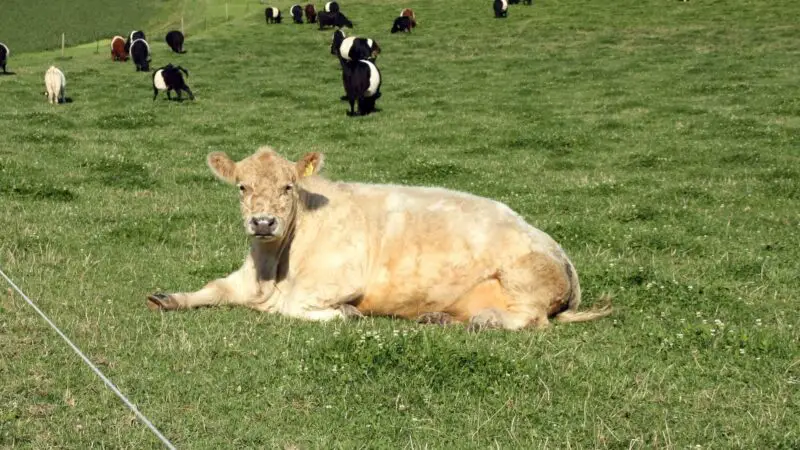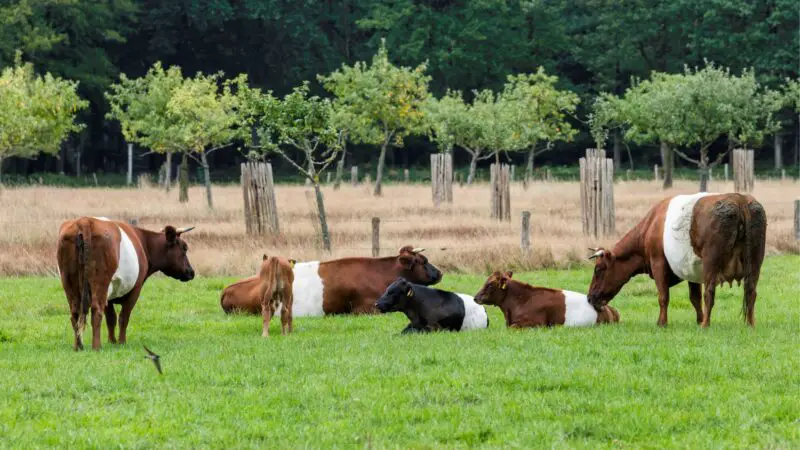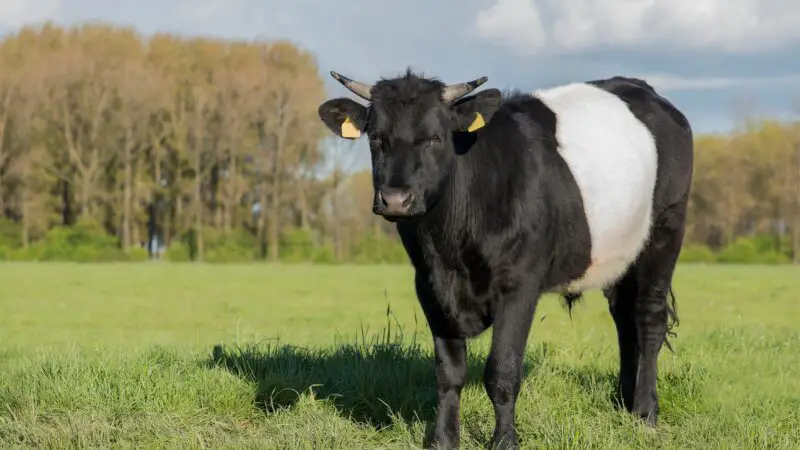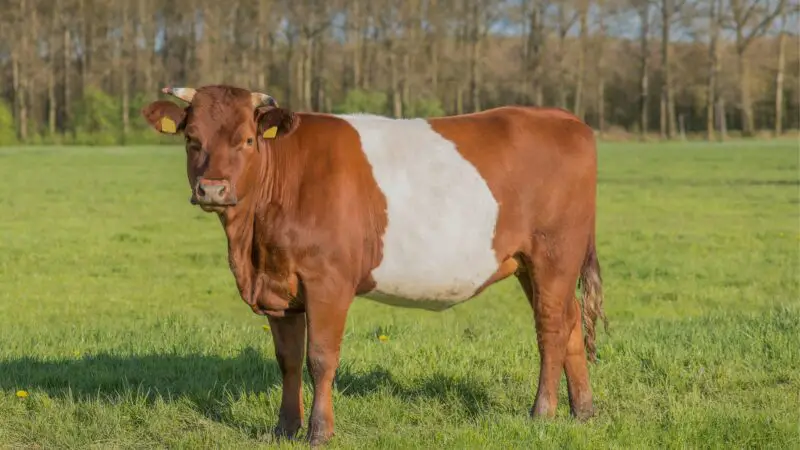Although raising cows is an expensive venture, it is fun and rewarding nonetheless. You must choose the right breed for you after knowing why you want to raise them: dairy, beef, or both! An interesting dual-purpose cow breed is the Dutch belted cattle.
Dutch belted cattle is characterized by its black or occasionally red body color and thick white-banded midsection. It is raised for both milk and beef due to its lean meat quality, foraging capacity, and ability to convert grains and pastures to up to 20,000 pounds of milk. An average cattle costs around $500 to $1,500.
To know more about this specific cow breed, its history and origins, physical attributes, distinctive characteristics, and other relevant information, simply read further this article!
Dutch Belted Cattle History

Dutch belted cattle is also known as the Lakenvelder or Lakenfield. This breed has existed as a purebred since the 17th century and as a standardized breed in the Netherlands in the 18th century.
They were sought-after animals by both the nobility and the working class due to their striking yet peculiar body markings. Ownership over them was first acquired by Holland royalty.
For centuries after they were discovered, the Lakenvelder were continuously bred and kept by the Dutch who were stingy in selling their prized cattle. This was why it was never a popular breed.
After World War II, the European populations of this cattle severely declined. By 1950, there were only 4 or 5 existing herds in Holland.
After a successful revival of the breed in Holland in the 1970s, the importation of the dairy breed into the United States was made possible by D. H. Haight, who was the U.S. Consul of Holland at that time and brought in the cattle in 1838. A famous showman, P. T. Barnum, made his importation of cattle and showed them for exhibition in his circus shows.
As of 2007, the Lakenvelder is now in a fairly good position in terms of their populations than it was in the past centuries.
What Is a Dutch Belted Cattle?
What Do Dutch Belted Cattles Look Like?
Dutch belted cattle have a classic triple wedge body shape like most dairy cattle with a broad and slightly concave head, long and slightly upward-curving horns, long and wide rump, and a good spring of rib.
For a cattle to be considered Dutch belted, its feet, horns, and tongue should be pigmented.
Their alternative name, the Lakenvelder or Lakenfield, is derived from the Dutch word laken, which means cloth or sheet, referring to the thick white band found across the midsection of the cattle, which usually extends from its shoulder down to its hip bones. Dutch belted cattle have a primarily black overall color, but they can occasionally be red.
How Long Does a Dutch Belted Cattle Live?
The average life expectancy of Dutch belted cattle is around 20 years old. They can calve annually from a sexually mature reproductive age of two until their teenage years.
What Do Dutch Belted Cattles Eat?
Pasture grasses, hay (alfalfa or dried grass), and silage (made out of alfalfa, fermented grasses, or corn). Breeders and owners also feed them with soybean meal, brewers grains, beet pulp, cottonseeds, citrus pulp, corn gluten feed, and waste (from candy and baked goods).
Additionally, they can consume about 100 pounds of feed and 30 to 50 gallons of water daily.
How Big Do Dutch Belted Cattles Grow?
Dutch belted cattle can reach a height of 49.6 to 53.5 inches at the shoulder. They are slightly shorter than the average dairy cattle, which usually measure 52 to 55 inches tall.
Are Dutch Belted Cattles a Heavy Breed?
Dutch belted cattle are relatively a heavy breed, with a typical weight of 900 to 1,500 pounds. Their milk has 3.5 to 5.5 percent butter fat, making them ideal milk producers. Dutch belted bulls weigh even heavier at around 1,350 to 2,000 pounds.
What Is Dutch Belted Cattle Known For?
Dutch belted cattle are a dual-purpose breed raised both for milk and beef due to their high milk and meat yields. They were originally considered hobby cattle.
Where Do Dutch Belted Cattles Originate?
The Lakenvelder lineage can be traced directly to the original belted, sheeted, or canvassed cattle, which were first described in Austria and Switzerland before being transported by Dutch nobility from the mountain farms of the Tyrol Mountains and Canton Appenzell to their home country.
What Are the Distinct Characteristics of a Dutch Belted Cattle?
Dutch belted cattle have small bone structures. They have unusually good fertility and longevity, which prompts them to calve easily.
Dutch Belted Cattle Temperament
Dutch belted cattle are known for their friendly, calm, and docile disposition. They are also quite intelligent.
Is a Dutch Belted Cattle Rare?

Dutch belted cattle are rare. This dairy breed faced near global extinction in the 1970s possibly because many dairy cattle were sold for their beef as a means to help increase milk prices.
The Livestock Conservancy categorizes the Dutch belted cattle as critical in their Conservation Priority list in 2021, with less than 300 individual cattle officially registered in the United States, about 1,512 in the Netherlands, and less than 1,000 existing worldwide.
Is Dutch Belted Cattle Meat Good?
Although known primarily for its dairy milking capacity, Dutch belted cattle meat is known to be tender, flavorful, and of superior quality, especially in the Netherlands, where various taste tests were conducted in 1996, 2007, and 2010.
Is Belted Galloway Meat Good?
Belted Galloway meat is popular for its tender, flavorful, and juicy taste. It comes as no shock that this breed is mainly raised for its lean meat quality.
How Much Does a Dutch Belted Cattle Cost?

As of this writing, a Dutch belted cattle costs around $500 to $1,500 depending on the breeder, age, milk quality (particularly what protein it consists of), and wholesale price.
How Much Milk Does a Dutch Belted Cow Produce?
Dutch belted cow can produce about 35 to 40 pounds of milk a day and will milk longer after each calving or giving birth. In fact, this breed can produce milk for about 9 to 11 months.
According to the Dutch Belted Cattle Association of America (DBCAA), the Lakenvelder can produce about 20,000 pounds of milk per lactation period.
During the 17th to 18 centuries, the Dutch belted cattle were chosen as a specialized dairy breed with the highly efficient capability to forage and graze, convert grain supplementation and lush green pastures into 12,000 to 15,000 pounds of high-quality milk.
To this day, they maintained this efficiency, as evidenced by producing more milk than they did in the past centuries.
Are Dutch Belted Cattle Good Pets?
Dutch belted cattle are good pets because of their temperament. However, it is costly to maintain them, so it is not recommended to keep them as pets unless you plan to raise them for beef and milk.
Tips in Taking Care of Dutch Belted Cattle
1. Dairy Facility Buildings
Construct a milking center using flat barns, parlors (herringbone, side-opening, or parallel), and carousels, then include a milk room, milking parlor, utility room, and a holding area. It is not necessary to build an office and a treatment area, but it is recommended to do so.
2. Housing
Housing for cattle can either be no housing, semi-confined, or confined. Regardless of the type of housing, starter calves should be housed in individual stalls that are 24 inches in width until they are 9 to 10 weeks old. As they grow, they can be transferred into larger-sized pens.
There should also be crowding pens of about 150 square feet capable of holding 5 to 6 cattle and holding pens that are 20 square feet of space per cattle.
3. Equipment
Cattle housing should be equipped with the proper facilities that can protect from muddy conditions and heat stress, as well as areas for resting and feeding. Here is the following necessary equipment:
- Feeding Equipment. Good quality and rugged feed bunks and portable hay feeders should be provided for the cattle. Make sure to prevent wastage as much as possible by purchasing feeders with the right height.
- Water Equipment. For grazing animals, they must have portable water tanks to minimize the impact of cattle in a single location. During the winter season, you may be required to provide heated watering equipment systems when they’re placed in the pasture, depending on the climate conditions of where you live.
- Headgate. This is the most essential part of any cattle working facility. It is a device used to secure the head of any cattle so that owners and veterinarians have easy access to the animal. Choose a headgate that is sturdy, easy to operate, and safe to use for your cattle.
4. Nutrition
Cattle weighing about 700 pounds or more should be fed with 11% crude protein in a feed ration usually composed of corn, roughage, and protein sources.
You can also use wheat and barley as alternatives for corn. Supplement their diets with additional hay, corn silage, mineral or vitamin supplements, and even waste products from candies and baked goods when necessary.
5. Health Maintenance
Young calves should get vaccinations and parasite treatment programs to reduce the risk of acquiring diseases, especially during the first 9 to 12 weeks of their life. The entire housing facility should be kept clean and well-ventilated. Have the cattle checked regularly.
Is It Expensive to Raise Dutch Belted Cattle?
Dutch belted cattle is expensive to raise. It takes about $500 to $1,000 to raise a single cattle annually.
This is composed of the following costs: feed, health program, electricity, facility and equipment repairs, labor charge, building expenses, and other variable costs.
How Much Space Does a Dutch Belted Cattle Need?

Generally, they need a stall width of 45 to 48 inches, a stall length of 8 to 8.5 feet, a neck rail height of 44 to 46 inches, and a curb-to-neck rail and brisket board of 66 inches.
They also need about 24 to 30 inches of bunk space. These dimensions can be decreased accordingly for cattle under 1,200 pounds.
What Is the Difference Between Dutch Belted and Belted Galloway?
Although they have a similar appearance, Dutch belted cattle have shorter hairs, are predominantly horned, and can be raised for both dairy and beef, while Belted Galloway cattle have longer hairs, are naturally polled, and are raised primarily for beef only.
